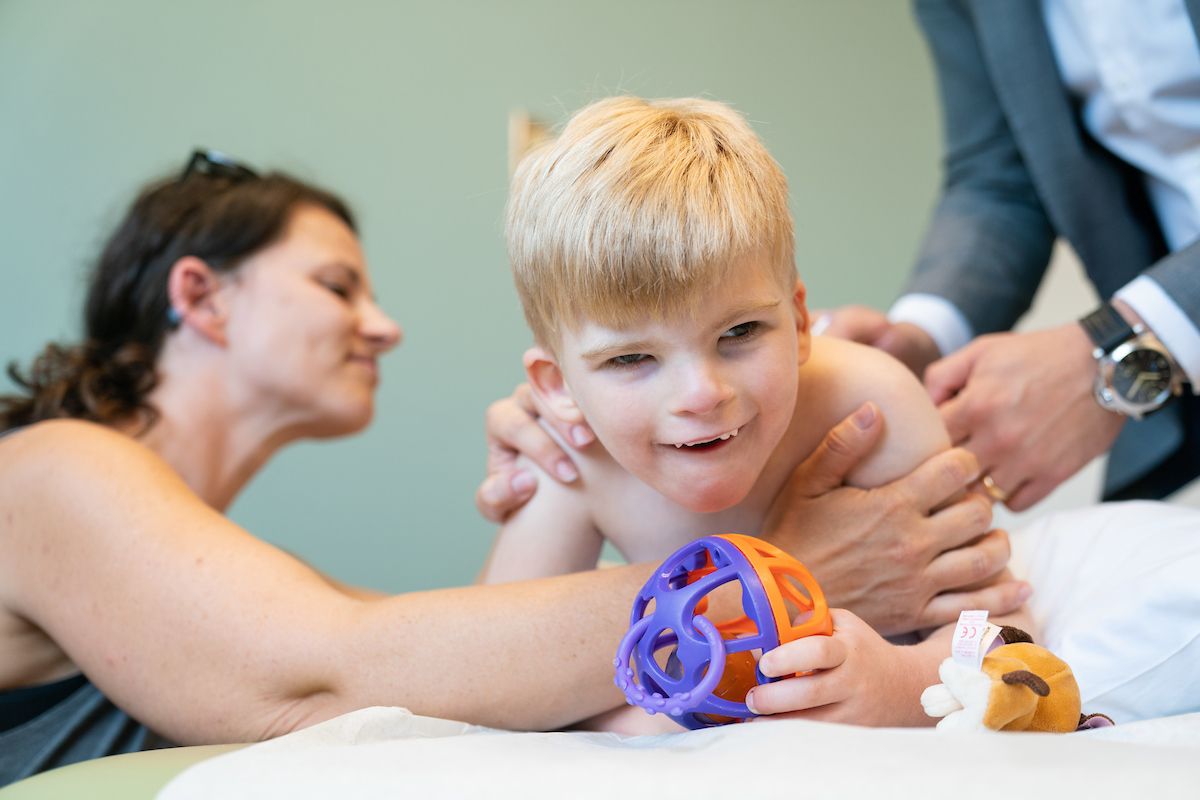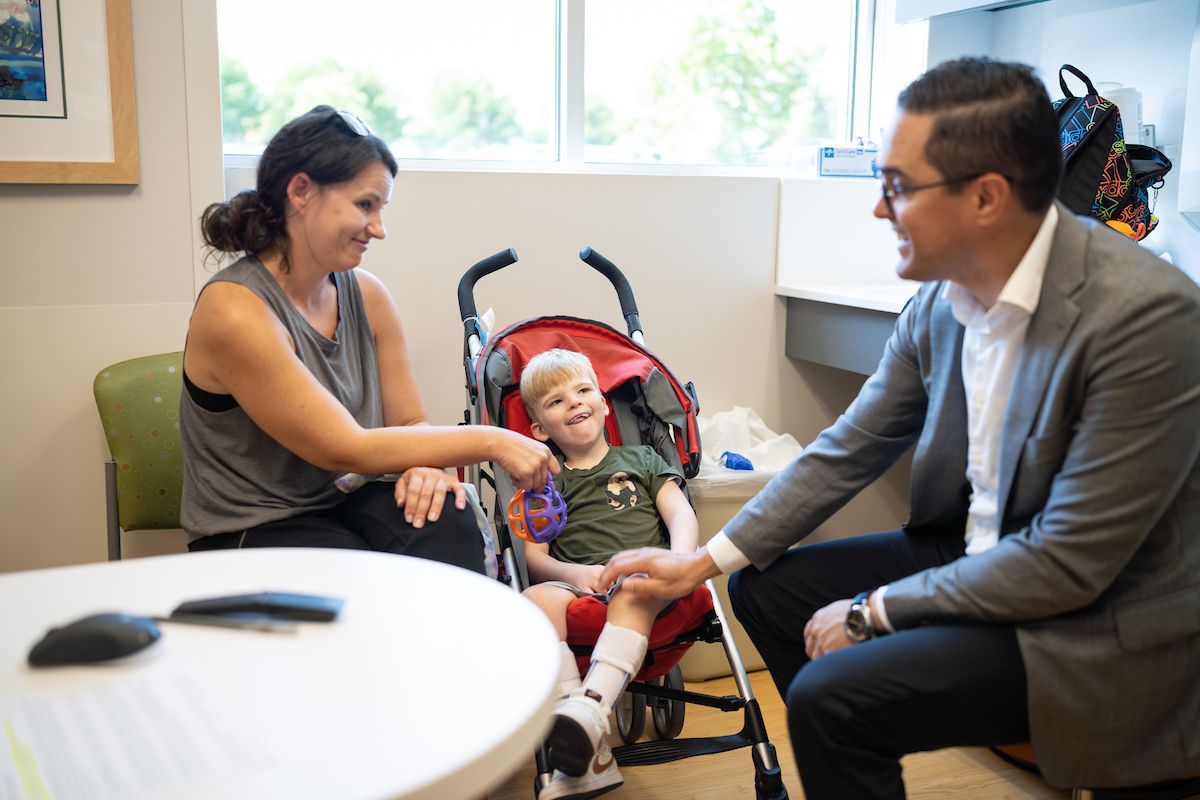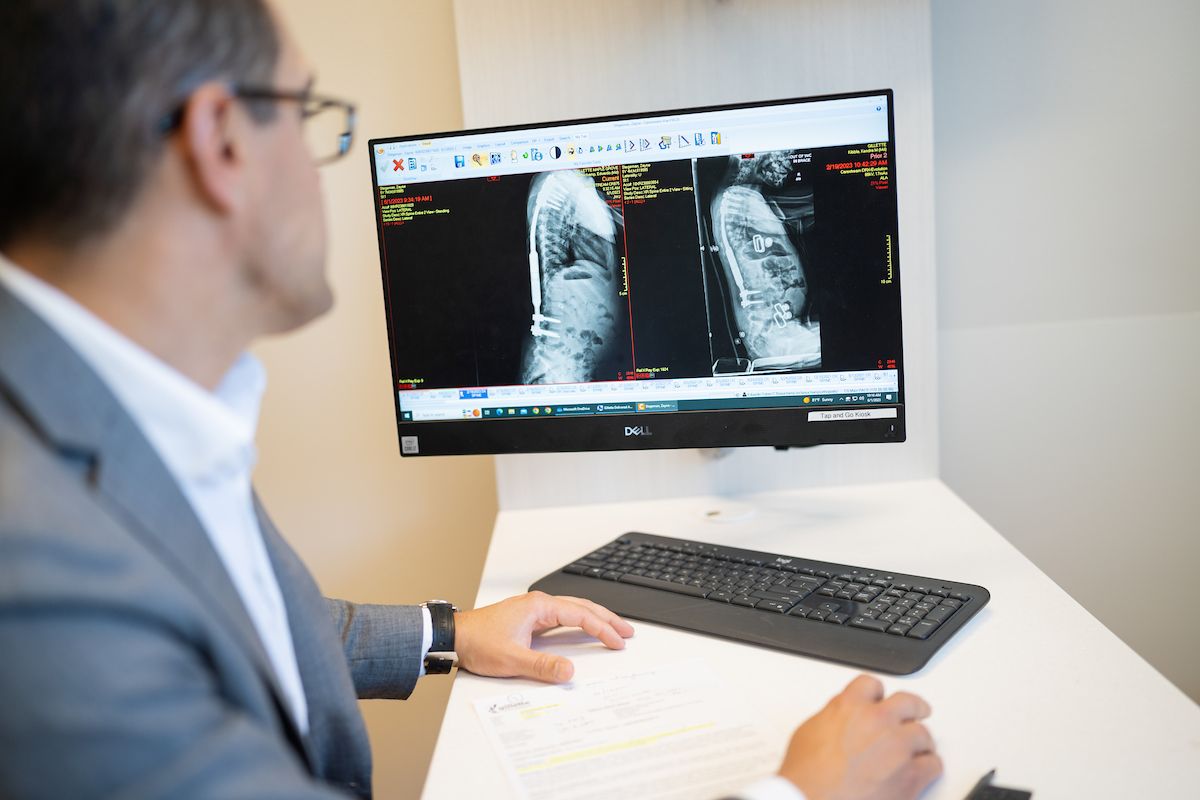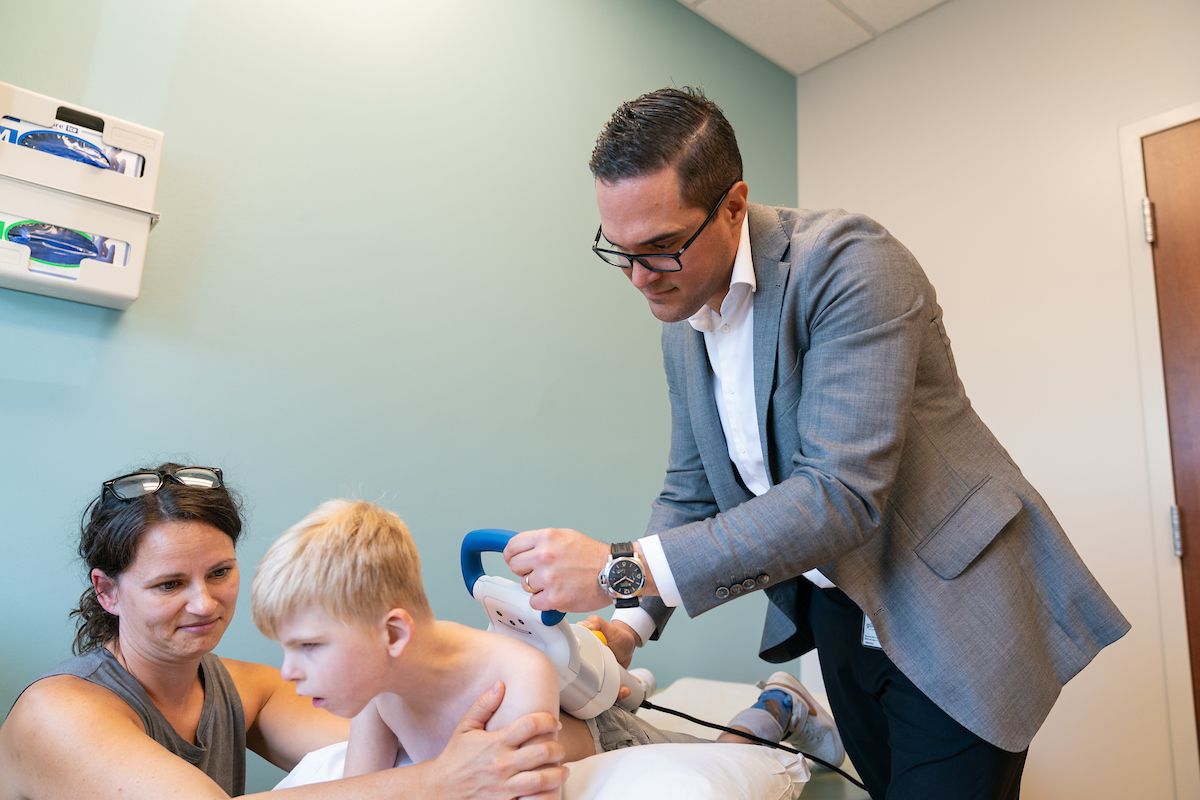
Jesse Stegeman is strong and does not quickly panic but when she heard her 4-year-old son, Zayne, would need spine surgery she admits feeling “terrified.”
That’s saying something for a mother of two who has been through a lot of medical complications with her youngest son, Zayne, who was born six weeks early.
“There was nothing really unusual about my pregnancy With Zayne,” Jesse recalls. “So, I was surprised when he was born early and brought to the special care nursery for observation.”

Jesse and Zayne Stegeman see pediatric spine surgeon, Eduardo Beauchamp, MD for spine care at the Gillette Children's Clinic in Maple Grove, MN.
"I had never heard of it..."
After Zayne’s birth, the medical providers noticed he was having difficulty breathing and eating so they began medical testing.
“A doctor came into my hospital room right after he was born and said, ‘Zayne has the textbook symptoms of cri-du-chat syndrome.’ I had never heard of it and was shocked,” Jess says.
Cri-du-chat syndrome, which translates to ‘cry of the cat’ in French, is a rare genetic disorder caused by missing pieces on a particular chromosome. The characteristics of a baby born with cri-du-chat include a high-pitched cry that has been associated with the sound of a kitten. It also includes a small head size, (microcephaly), low birth weight, craniofacial malformations, and developmental delays.
Most cases of cri du chat syndrome are not inherited—meaning both parents have no family history of the disorder. Right now, there is no known cure for cri du chat, but early diagnosis and intervention can help children reach their full potential.

Jesse and Zayne Stegeman are grateful for pediatric spine surgeon, Eduardo Beauchamp, MD, and his team at Gillette.
A curve in his spine
The Stegeman family lives in Mora, MN which is about 60 miles northwest of Minneapolis. When Zayne was about a year old, a school occupational therapist told Jesse it would be a good idea to have Zayne receive care from a physical medicine and rehabilitation physician (PM&R). Zayne’s primary physician suggested Gillette Children’s as the best place for Zayne to work with a specialist in his rehabilitation care and medical management.
“At one of Zayne’s first appointments at Gillette the team did a big ‘work up’ and discovered a slight curve in his spine and they thought it could be scoliosis,” Jesse recalls.
“The doctors said Zayne’s spine was still growing and initially the curve was not severe,” Jesse says. “We were dealing with so many other medical issues with Zayne and it was not easy to be told that the best thing was to ‘wait and see.’ The waiting was really hard.”
Gillette is a nationally and internationally recognized leader in pediatric orthopedics and in the treatment of pediatric spine conditions, including scoliosis.
Gillette Children’s Spine Institute is a world-class center specializing in complex spinal disorders, offering personalized surgical and non-surgical treatments. The institute offers comprehensive support services, including physical therapy, educational resources, and well-being support to empower patients and their families throughout their treatment journey.
A strong team for Zayne
Jesse Stegeman is incredibly thankful Zayne receives care from a large team of experts at Gillette. “The doctors are awesome,” Jesse beams. “The support staff, nurses, schedulers, and everyone is just wonderful, and they truly care.”
Stegeman is particularly grateful for two members of Zayne’s team—Gillette physical medicine and rehabilitation physician, Andrea Paulson, MD and pediatric spine surgeon, Eduardo Beauchamp, MD.
“Doctor Paulson is ON it and is one of our favorite doctors that we see anywhere!” Jesse raves. “She is a champion to make sure people who live in Greater Minnesota have access to care. Dr. Paulson spends so much time with us and explains things in a way I can understand.”
Jesse says she’s impressed with Dr. Beauchamp and the spine team. “Dr. Beauchamp works hand and hand with Dr. Paulson and the rest of Zayne’s team,” Jesse says. “He reassured me when it came time to make decisions about Zayne’s scoliosis care.”

Gillette pediatric spine surgeon, Eduardo Beauchamp, MD, is an expert in caring for scoliosis and in interventions to help spine health.
A plan for Zayne's spine
Zayne’s spine continued to curve, and his scoliosis got to a point where Beauchamp and his team suggested care and interventions.
“I first met Zayne when he was 2 years old,” Dr. Beauchamp recalls. “At that point, his thoracic curve was mild, therefore we pursued non-operative interventions.”
Dr. Beauchamp suggested the first step for Zayne would be bracing. The purpose of a brace is to slow or stop the progression of the curve. Unfortunately, in most cases, wearing a brace cannot improve or straighten a curve in the spine.
Dr. Beauchamp put Zayne in a full time Thoraco-Lumbo-Sacral Orthosis (TLSO). This type of brace is made of plastic and foam and extends from a child’s upper arm pits to just below their hips.
“Zayne wears his brace 23 hours a day,” his mother, Jesse says. “Surprisingly, he tolerates it really well, but the brace did not stop the progression of his curve.”

Gillette pediatric spine surgeon, Eduardo Beauchamp, MD, makes an adjustment to the magnetically driven growing rods, known as MAGEC rods, in Zayne's spine.
MAGEC time
As Zayne grew, unfortunately, his thoracic curve continued to progress. Dr. Beauchamp suggested Zayne undergo surgery using magnetically controlled growing rods known as MAGEC® rods.
“Due to the magnitude of the curve, we recommended surgical intervention to try to control and correct his curve, while allowing his lungs to develop and his chest wall to continue to grow,” Dr. Beauchamp says.
“Zayne’s plan of care was developed through a multidisciplinary approach that involved spine surgeons, anesthesiologists, and complex care pediatricians,” Dr. Beauchamp adds.
Gillette is an international leader in the MAGEC rod procedure that involves placing two rods in a patient’s back to straighten a patient’s spine, while allowing the chest wall to grow as the patients grow. MAGEC rods are one of the potential treatment options to treat early onset scoliosis (EOS). EOS is when a child under age 10 has a curve in their spine that’s greater than 10 degrees. The MAGEC rods are surgically placed on either side of the spine to help control the curve.
Following the surgery, the system uses magnets to lengthen the rods as the patient continues to grow. The magnets allow the patient to avoid one of the major drawbacks of a traditional rod system—needing surgery every three to six months to adjust the implanted rods.
Why it is called MAGEC rods
Jesse Stegeman was apprehensive that Zayne might not react well to his first lengthening session with Dr. Beauchamp at the Gillette Maple Grove Clinic.
“I really didn’t know what to expect,” Jesse says. “I really was concerned at first, but I read a few blog posts on the Gillette website about this procedure, and it really helped to educate me and not feel as worried.”
During the rod lengthening procedure Dr. Beauchamp makes small marks with a pen on Zayne’s back to mark the spot where the rods should be lengthened. An external controller is then placed on Zayne’s back and activated. There is a slight buzzing sound as the controller device magnetically expands the rods to the pre-determined length.
Dr. Beauchamp followed the same actions to lengthen Zayne’s second MAGEC rod. In just a few minutes Zayne and his mother were packing up to head home to Mora.
“I’m pretty amazed that this simple lengthening procedure went so well and it’s great that Zayne can avoid another surgery,” Jesse says. She smiles and adds “It sounds a bit funny, but I can now really see why they call them MAGEC rods!”
Meet a care team provider, find a location, learn how to get a second opinion, and more.
Request an appointment to connect with Gillette providers.
Do these symptoms sound familiar? Our 30-minute consult appointment could help get answers.
